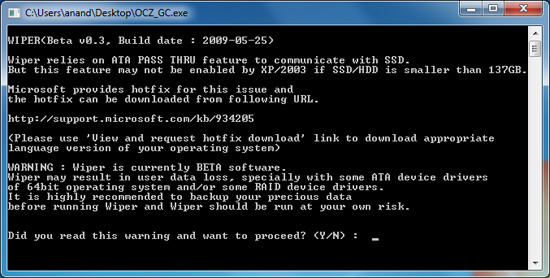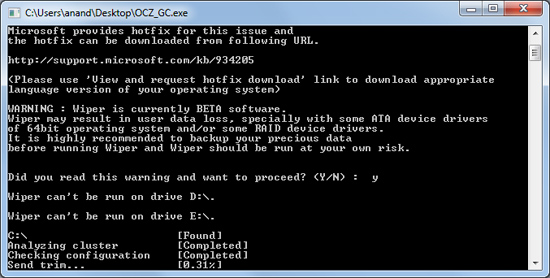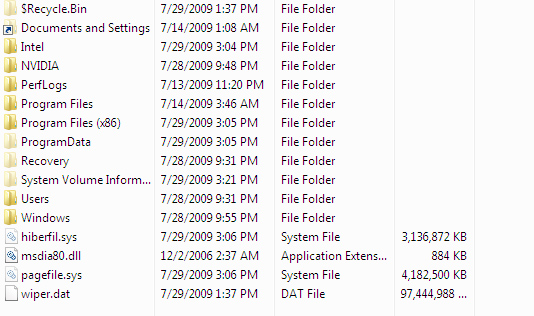The SSD Relapse: Understanding and Choosing the Best SSD
by Anand Lal Shimpi on August 30, 2009 12:00 AM EST- Posted in
- Storage
The Wiper Tool
The only Microsoft OS with TRIM support is Windows 7. Windows XP and Vista users are out of luck when it comes to TRIM, even if your drive supports it, the OS will never send it the command. Luckily there’s a workaround, one first popularized by Indilinx - not Intel. Kudos to the Indilinx guys.
It’s called the Indilinx Wiper Tool.

The tool asks the OS for all available LBAs (free space as far as the OS is concerned), then feeds the list to the SSD and tells the drive to TRIM those LBAs - prioritizing them for cleaning. It shouldn’t touch valid data, the key word being shouldn’t. Once cleaned, with no existing data in those blocks, performance goes back to its new state.

It’s a very simple solution actually. TRIM works because the OS knows when a file is deleted and it uses the TRIM command to inform the SSD of the deletion. Don’t have OS level TRIM support? Well, just run a tool that asks the OS what locations aren’t in use any longer. You get the same result, it just takes one extra step: running the wiper tool.

See wiper.dat? It's eating up all available LBAs then telling the controller to TRIM those blocks. Clever.
I tested the Wiper Tool to make sure it worked as promised and indeed it did, I actually showed you the results at the beginning of this story. One pass of the tool and the drive went from used to new performance:
| PCMark Vantage HDD Score | New | "Used" | After TRIM/Idle GC | % of New Perf |
| OCZ Vertex Turbo (Indilinx MLC) | 26157 | 25035 | 26038 | 99.5% |
You’ll need to get the tool from your drive vendor and it currently works under both 32-bit and 64-bit Windows OSes (XP through 7). I found that it works best in IDE mode; with your controller set to RAID or AHCI I’ve seen issues where the manual trim process can easily take more than several hours. When running properly it takes a couple of minutes to trim an entire drive.
You don’t need to run the tool that often (Indilinx drives don’t drop significantly in real world performance anyway) and once we get official TRIM support, Windows 7 users won’t need to do anything at all. But until then it does provide a nice way to keep your drive fresh.










295 Comments
View All Comments
Anand Lal Shimpi - Monday, August 31, 2009 - link
I believe OCZ cut prices to distributors that day, but the retail prices will take time to fall. Once you see X25-M G2s in stock then I'd expect to see the Indilinx drives fall in price. Resellers won't give you a break unless they have to :)Take care,
Anand
bobjones32 - Monday, August 31, 2009 - link
Another great AnandTech article, thanks for the read.Just a head's-up on the 80GB X-25m Gen2 - A day before Newegg finally had them on sale, they bumped their price listing from $230 to $250. They sold at $250 for about 2 hours last Friday, went back out of stock until next week, and bumped the price again from $250 to $280.
So....plain supply vs. demand is driving the price of the G2 roughly $50 higher than it was listed at a week ago. I have a feeling that if you wait a week or two, or shop around a bit, you'll easily find them selling elsewhere for the $230 price they were originally going for.
AbRASiON - Monday, August 31, 2009 - link
Correct, Newegg has gouged the 80gb from 229 to 279 and the 160gb from 449 to 499 :(Stan Zaske - Monday, August 31, 2009 - link
Absolutely first rate article Anand and I thoroughly enjoyed reading it. Get some rest dude! LOLJaramin - Monday, August 31, 2009 - link
I'm wondering, if I were to use a low capacity SSD to install my OS on, but install my programs to a HDD for space reasons, just how much would that spoil the SSD advantage? All OS reads an writes would still be on the SSD, and the paging file would also be there. I'm very curious about the amount of degradation one would see relative to different use routines and apps.Anand Lal Shimpi - Monday, August 31, 2009 - link
Putting all of your apps (especially frequently used ones) off of your SSD would defeat the purpose of an SSD. You'd be missing out on the ultra-fast app launch times.Pick a good SSD and you won't have to worry too much about performance degradation. As long as you don't stick it into a database server :)
Take care,
Anand
swedishchef - Tuesday, September 1, 2009 - link
What if you just put your photoshop cache on a pair of Velociraptors? Would it be the same loss of benefit?I have the same question regarding uncompressed HD video work, where I need write speeds well over the Intel x25-m ( over 240Mb/s). My assumption would be that I could enjoy the fast IO and App. launch of an SSD and increase CPU performance with the SSD while keeping the files on a fast external or internal raid configuration.
Thank you again for a a brilliant Article Anand.
I have been waiting for it for a long time. Yours are the only calm words out on the net.
Grateful Geek /Also professional image creator.
creathir - Monday, August 31, 2009 - link
Great article Anand. I've been waiting for it...My only thoughts are, why can't Intel get their act together with the sequential business? Why can the others handle it, but they can't? To have such an awesome piece of hardware have such a nasty blemish is strange to me, especially on a Gen-2 product.
I suppose there is some technical reason as to why, but it needs to be addressed.
- Creathir
Anand Lal Shimpi - Monday, August 31, 2009 - link
If Intel would only let me do a deep dive on their controller I'd be able to tell you :) There's more I'd like to say but I can't yet unfortunately.Take care,
Anand
shotage - Monday, August 31, 2009 - link
Awesome article!I'm intrigued with the cap on the sequential reads that Intel has on the G2 drives as well. I always thought it was strange to see even on their first gen stuff.
I'm assuming that this cap might be in place to somehow ensure the excellent performance they are giving with random read/writes. All until TRIM finally shows up and you'll have to write up another full on review (which I eagerly await!).
I can't wait to see what 2010 brings to the table. What with the next version of SATA and TRIM just over the horizon, I could finally get the kind of performance out of my PC that I want!!